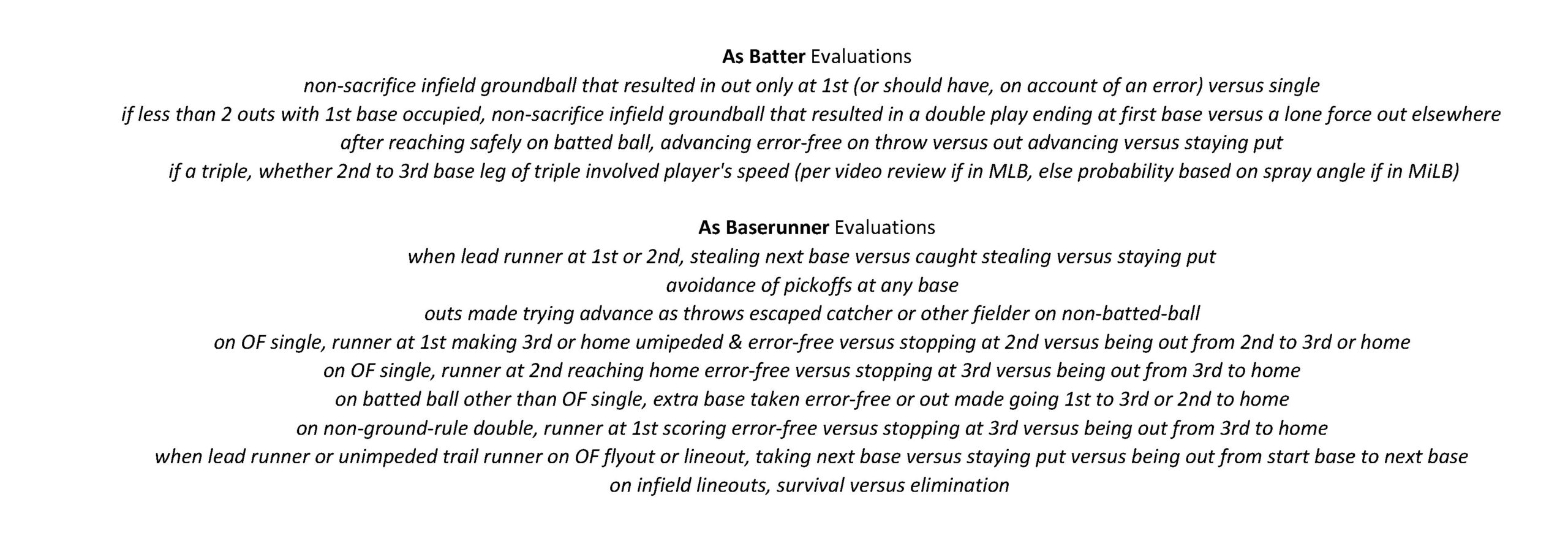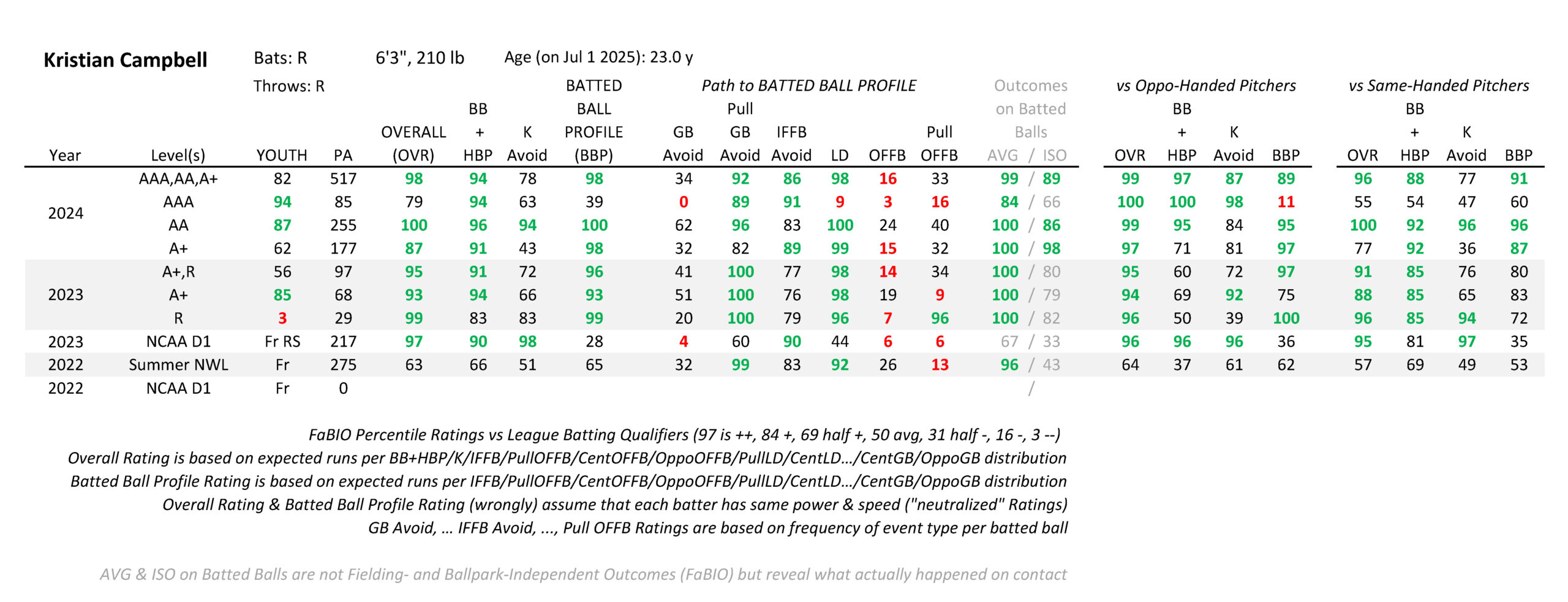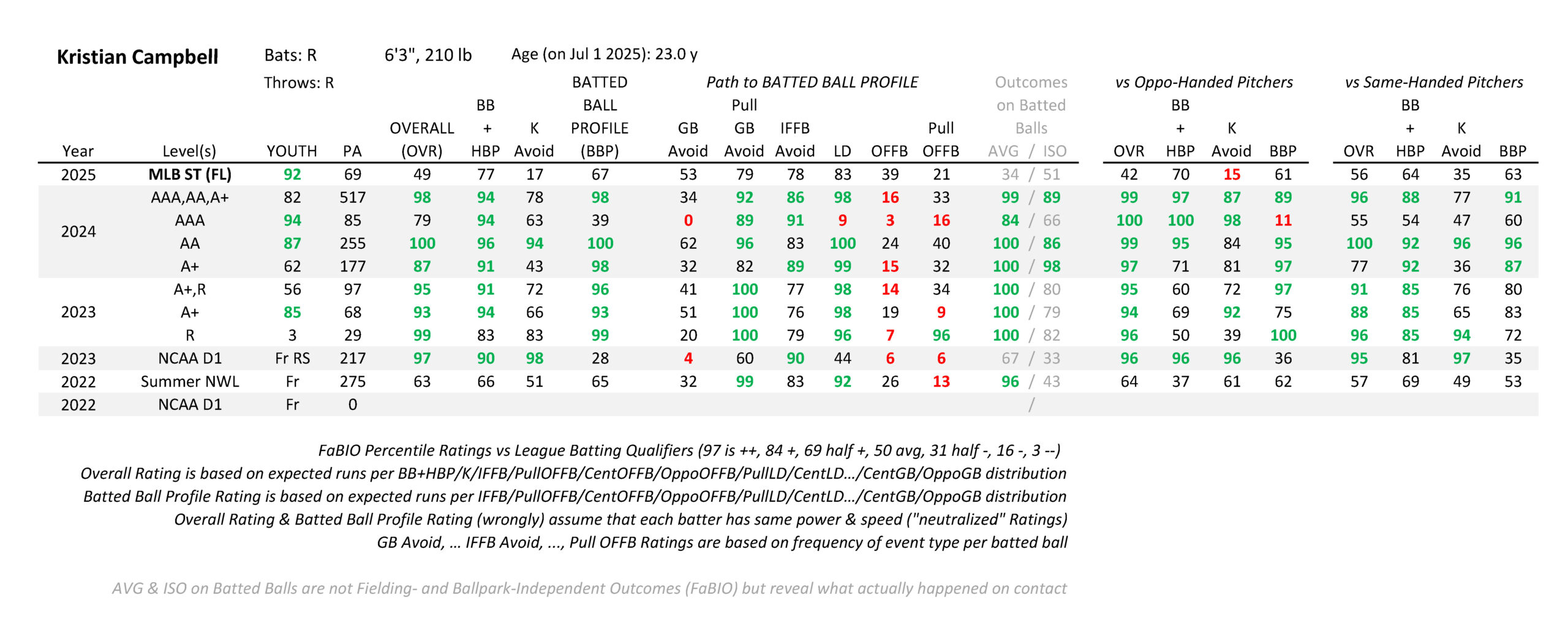Kristian Campbell's fantasy baseball prospect outlook, sleeper potential for dynasty leagues. Matt uses his custom suite of fundamentals-rooted evaluation tools.
Red Sox rookie infielder-outfielder Kristian Campbell first tripped the wires of the FaBIO batter evaluation model not long after his completion of a long 2022 summer spent in the wood bat Northwoods League. That summer and the subsequent spring as an NCAA Division 1 redshirt freshman would represent the entirety of his college baseball experience.
How did his plate fundamentals rate then in comparison to those that have followed in the pros? How has offensive running graded out relative to MiLB peers? What does this data and information portend for his underway MLB career?
Let's investigate Campbell's stats and rise to determine how great of a prospect he will become in his future.
Be sure to check all of our fantasy baseball lineup tools and resources:- Fantasy baseball trade analyzer
- BvP matchups data (Batter vs. Pitcher)
- PvB matchups data (Pitcher vs. Batter)
- Who should I start? Fantasy baseball comparisons
- Daily MLB starting lineups
- Fantasy baseball closer depth charts
- Fantasy Baseball live scoreboard
- Fantasy baseball injury reports
Brief Explanation of the FaBIO Model
My Fielding- and Ballpark-Independent Outcomes (FaBIO) evaluation model sorts every plate appearance into one of 12 outcome bins (BB+HBP, K, IFFB, Pull-Third OFFB, Center-Third OFFB, Oppo-Third OFFB, Pull-Third LD, Center-Third LD, Oppo-Third LD, Pull-Third GB, Center-Third GB, Oppo-Third GB) and charges the pitcher and batter with their league's mean runs value for said particular event that season.
Dividing a batter's total number of expected runs by plate appearance (PA) yields expected runs per PA that can be percentile ranked relative to the league mean and standard deviation for that parameter amongst league batter qualifiers to arrive at their Overall Rating.
Its three subcomponents, BB+HBP Rating (based on BB+HBP per PA), Strikeout Avoid Rating (K Avoid, based on K per PA), and Batted Ball Profile Rating (expected runs per batted ball), are also reported to identify the path the batter traveled to reach their Overall Rating.
Overall Rating and Batted Ball Profile Rating of batters should be considered power- and speed-neutralized metrics since the real-world runs value of a single batter's typical OFFB or LD varies with their strength, and the expected runs value of their typical GB varies with their speed.
To better understand the Path to Batted Ball Profile, we will also examine percentile ratings for select batted ball event types (on a per-batted ball basis). To check how well expected batted ball outcomes match real-world ones, we will compute percentile ratings for hits (AVG) and isolated power (ISO, or simply extra bases) on batted balls (recognizing full well that these two parameters are neither fielding- nor ballpark-independent outcomes).
What most explains a batter's ability to generate hits (AVG) on batted balls is any LD, IFFB avoidance, Pull-Third OFFB, and Pull-Third GB avoidance. What most explains their ability to generate extra bases (ISO) on batted balls is any OFFB, Pull-Third OFFB, Pull-Third LD, and IFFB avoidance.
A percentile rating of 97 amounts to plus-plus (two standard deviations above the mean), 84 is plus (one standard deviation above the mean), 69 is half plus, 50 is average, 31 is half minus, 16 is minus, and three is minus-minus.
A new addition to this suite of evaluation models is the Offensive Running Rating. This tool quantifies how each relevant inning's run expectancy was impacted by the player's action or inaction as either a batter or baserunner on very specific types of plays that are more likely to involve one or both of their speed or offensive running technique, plus acumen.
The evaluated batter and baserunner events are summarized in the graphic.
Prospect Analysis: Kristian Campbell
Evolution of College Plate Profile
A perhaps physically underdeveloped Campbell was redshirted for a would-be 2022 freshman season at Georgia Tech. Then came a huge-sample 275 PA stint in wood bat Northwoods League. A 65 Batted Ball Profile Rating there belies a rather elite singles-promoting LD + IFFB Avoid + Pull GB Avoid trio that paved way to a 96 AVG on Batted Balls Rating. Big hit fundamentals with average K Avoid and near half plus BB+HBP Rating put Campbell on the scouts' radar one summer before he would be draft-eligible via the age rather than college years completed route.
In mid-April of the 2023 redshirt freshman year back in Atlanta, Campbell sported a 75 LD/92 IFFB Avoid/78 Pull GB Avoid trio that mainly explained an 85 AVG on Batted Balls. But a later-season dip in LD would cause the hit fundamentals and outcomes in that row of the table to end up not so impressive.
One big change from the 2023 summer to the 2024 spring evident in the GB Avoid and OFFB columns was Campbell morphing from a relatively low launcher in the Northwoods League into an extremely low launcher at Georgia Tech. Others are easier to spot as the 2024 D1 BB+HBP Rating was 1.5 plus while its K Avoid counterpart topped double plus.
The Red Sox selected Campbell with the first compensation pick after the completion of the regular phase of the fourth Round of the 2023 MLB Draft and reached an agreement on a signing bonus of just under half a million.
Evolution of Pro Plate Profile
Red Sox instructors added some but not a ton of loft to the batted ball profile during a 97 PA rookie complex league affiliate and then a high-A pro debut. The big gains versus 2023 D1 came in the LD, Pull GB Avoid, and AVG columns, as those Ratings soared above and beyond the stellar 2022 summer ones. Also of note was that Campbell generated an almost plus ISO Rating on Batted Balls despite only generating minus OFFB and half minus Pull OFFB Ratings.
About all that went wrong in a phenomenal 2024 journey from High A through AA into AAA was a 43 K Rating to begin the year in High A and a 9 LD Rating in the 85 AAA PA. The 100 Overall in the AA leg was fueled by among the more complete sets of plate fundamentals posted by any 2024 MiLBer at one affiliate.
Campbell's first full MLB spring camp got off to a rocky start as he disproportionately struck out over the first 10 PA. By the end of spring, his K Rating had crept above minus while each of the historically stouter LD/IFFB Avoid/Pull GB Avoid trio were pushing full plus. Between the 17 K Avoid and the 34 AVG on Batted Balls was not up to par for the “hit trio” Ratings, whether Campbell was ready for MLB remained in question when he was announced to have made the Opening Day roster.
As a wrap, allow your eyes to wander up and down LD + IFFB Avoid + Pull GB Avoid columns. Consider how those consistently high trios fuel the very high AVG ratings while also adding bonus more-often-in-the-park extra bases that allow ISO production to exceed expectations that come with lower OFFB and Pull OFFB frequencies like these. Then scroll the BB+HBP column and imagine how often this batter stands to reach at least first base.
Evolution of Pro Offensive Running
Campbell had only a double minus three Offensive Running Rating in his 2023 MiLB debut over 99 event-relevant team PA. Over 171 PA in a 2024 return to High-A, he earned a near half minus 25 mark.
The 2024 AA stint that begat such stellar plate profile fundamentals also coincided with an offensive running breakout as Campbell rated plus plus 97 over 259 team PA. That new wrinkle in his offensive game would not travel with him up to AAA, where he managed only a minus-15 mark across 83 PA.
The circa 77th percentile MLB sprint speeder is unlikely to rate as a double-plus offensive runner in MLB. A more realistic expectation for Campbell ahead would be half to full plus as developmental offensive emphasis gradually shifts from hitting to the finer points of running.
Dynasty Fantasy Baseball Focus
Kristian Campbell projects to be the rarer right-handed batter who can contend for league batting average titles, owing to a stouter mix of batted ball profile fundamentals that skew hit over power. Are some old enough to remember Moises Alou as a leaner, similarly tall, right-handed-batting hit machine?
From a player development standpoint, one ought not try to raise his batted ball launch too much or too fast chasing power as there would be a danger of undermining premium hit fundamentals. The relative loss of hits via a much higher prevalence of easier-out outfield flyballs would not justify the relative gains in extra bases in this earlier phase of his career in which he will play lighter and faster.
Instead, let him remain a relative but not an extreme low launcher who gradually adds some outfield flyballs while increasingly recognizing and seizing on outfield flyball pull opportunities (pitches semi-up+middle to down+in esp.) as they come and more frequently pulling the relatively fewer outfield flyballs that are hit.
Batted ball outcomes portion of the Campbell plate offensive profile forecast identifies a 1.5 plus hitter who produces half plus extra bases on batted balls despite a below average frequency of outfield flyballs. Otherwise, expect plus walks, hit-by-pitches, and half plus strikeout avoidance on the non-batted-ball profile side.
Connect the dots between the projected hit and walk outcomes and this athlete who has played relatively minor baseball since high school will sport very high MLB on base percentages that will allow him to make frequent use of his work-in-progress half to full plus offensive running ability.
Perhaps the greatest mystery or debate today is where Campbell is best deployed within the spectrum of possible MLB defensive positions.
Download Our Free News & Alerts Mobile App
Like what you see? Download our updated fantasy baseball app for iPhone and Android with 24x7 player news, injury alerts, sleepers, prospects & more. All free!

More Fantasy Baseball Advice





 RADIO
RADIO




























